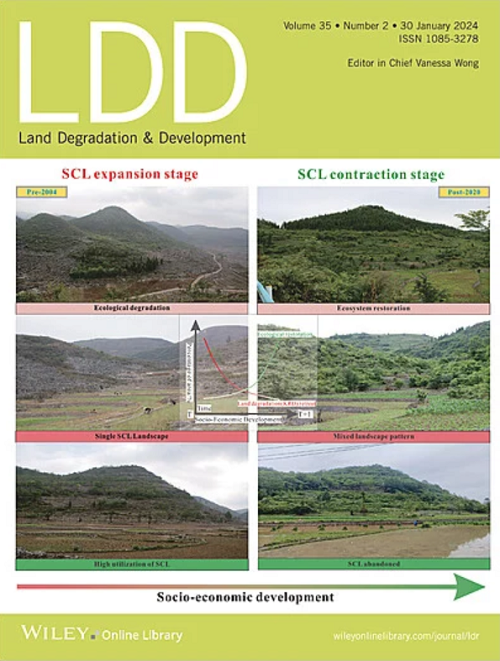干旱区内陆河流域绿洲扩张对水量服务的影响——以艾比湖流域为例
IF 3.6
2区 农林科学
Q2 ENVIRONMENTAL SCIENCES
引用次数: 0
摘要
在气候变化和人类活动的双重驱动下,绿洲扩张对干旱内陆河流域的生态系统服务产生了深远的影响。然而,以往的研究主要集中在大尺度的气候或土地利用变化上,缺乏对绿洲扩张如何具体驱动这些流域的水量动态的精细时空分析。为填补这一关键空白,本研究以鄂比湖流域为例,采用局地校准的InVEST模型结合Geodetector分析,系统量化了2000 - 2020年绿洲扩张对流域水量的时空演变和影响。水量是支撑生态稳定和可持续资源管理的重要供给服务。结果表明,绿洲面积显著扩大(+2.04 × 103 km2 / 10年),而水量呈下降趋势(- 8.58 mm / 10年)。值得注意的是,高产水量值集中在邻近山区,而绿洲地区的总供水量呈先上升后下降的趋势,2010年是一个明显的转折点。降水量是决定水量的主要因素,降水量和气温的综合影响是影响水量空间分布的最关键因素。InVEST模型引入局域化参数,提高了内陆河流域水量评价的准确性。这些发现强调了将绿洲扩张和气候变化纳入水资源管理战略的重要性,为类似干旱地区绿洲生态系统服务的可持续评价和管理提供了有价值的见解。本文章由计算机程序翻译,如有差异,请以英文原文为准。
Impact of Oasis Expansion on Water Yield Services in Arid Inland River Basins: A Case Study of the Ebinur Lake Basin
Oasis expansion—driven by both climate change and human activities—profoundly impacts ecosystem services in arid inland river basins. However, previous studies have predominantly focused on broad-scale climatic or land use changes, lacking a fine-scale spatiotemporal analysis of how oasis expansion specifically drives water-yield dynamics in such basins. To fill this critical gap, this study uses the Ebinur Lake Basin as a representative case, employing a locally calibrated InVEST model combined with Geodetector analysis to systematically quantify the spatiotemporal evolution of water yield and examine the influence of oasis expansion from 2000 to 2020. Water yield is a vital provisioning service underpinning ecological stability and sustainable resource management. Our results indicate that the oasis area expanded significantly (+2.04 × 103 km2 per decade), whereas water yield experienced a declining trend (−8.58 mm per decade). Notably, high water yield values remained concentrated in the adjacent mountainous regions, while the total water supply within oasis areas followed a “rise-then-fall” pattern, with 2010 marking a distinct turning point. Precipitation emerged as the primary determinant of water yield, and the combined influence of precipitation and temperature was found to be the most critical factor shaping its spatial distribution. The introduction of localized parameters into the InVEST model enhances the accuracy of water yield assessments in inland river basins. These findings underscore the importance of incorporating both oasis expansion and climatic variability into water resource management strategies, offering valuable insights for the sustainable evaluation and management of oasis ecosystem services in similar arid regions.
求助全文
通过发布文献求助,成功后即可免费获取论文全文。
去求助
来源期刊

Land Degradation & Development
农林科学-环境科学
CiteScore
7.70
自引率
8.50%
发文量
379
审稿时长
5.5 months
期刊介绍:
Land Degradation & Development is an international journal which seeks to promote rational study of the recognition, monitoring, control and rehabilitation of degradation in terrestrial environments. The journal focuses on:
- what land degradation is;
- what causes land degradation;
- the impacts of land degradation
- the scale of land degradation;
- the history, current status or future trends of land degradation;
- avoidance, mitigation and control of land degradation;
- remedial actions to rehabilitate or restore degraded land;
- sustainable land management.
 求助内容:
求助内容: 应助结果提醒方式:
应助结果提醒方式:


